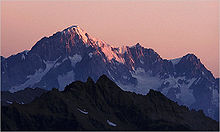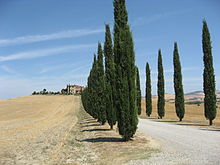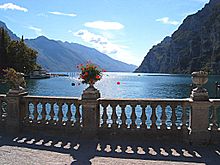- Climate of Italy
-
Italy has a variety of climate systems. The inland northern areas of Italy (for example Turin, Milan, and Bologna) have a Humid subtropical climate (Köppen climate classification Cfa), while the coastal areas of Liguria and the peninsula south of Florence generally fit the Mediterranean climate profile (Köppen climate classification CSa).
Between the north and south there can be a considerable difference in temperature, above all during the winter: in some winter days it can be −2 °C (28.4 °F) and snowing in Milan, while it is 8 °C (46.4 °F) in Rome and 20 °C (68.0 °F) in Palermo. Temperature differences are less extreme in the summer.
The east coast of the peninsula is not as wet as the west coast, but is usually colder in the winter. The east coast north of Pescara is occasionally affected by the cold bora winds in winter and spring, but the wind is less strong here than around Trieste. During these frosty spells from E–NE cities like Rimini, Ancona, Pescara and the entire eastern hillside of the Apennines can be affected by true "blizzards". The town of Fabriano, located just around 300 m (984 ft) in elevation, can often see 0.5–0.6 m (1 ft 7.7 in–1 ft 11.6 in) or 50–60 cm (19.7–23.6 in) of fresh snow fall in 24 hours during these episodes.
On the coast from Ravenna to Venice and Trieste, snow falls more rarely: during cold spells from east, the cold can be harsh but with bright skies; while, during the snowfalls that affects Northern Italy, the Adriatic coast can see a milder Sirocco wind which makes snow turn to rain—the mild effects of this wind often disappear just a few kilometres inside the plain, and sometimes the coast from Venice to Grado sees snow while it is raining in Trieste, the Po River mouths and Ravenna. Rarely, the city of Trieste may see snow blizzards with north-eastern winds; in the colder winters, the Venice Lagoon may freeze, and in the coldest ones even enough to walk on the ice sheet.[1]
Summer is usually more stable, although the northern regions often have thunderstorms in the afternoon/night hours and some grey and rainy days. So, while south of Florence the summer is typically dry and sunny, in the north it tends to be more humid and cloudy. Spring and Autumn weather can be very changeable, with sunny and warm weeks (sometimes with Summer-like temperatures) suddenly broken off by cold spells or followed by rainy and cloudy weeks.
In the north precipitation is more evenly distributed during the year, although the summer is usually slightly wetter. Between November and March the Po valley is often covered by fog, especially in the central zone (Pavia, Piacenza, Cremona and Mantua), while the number of days with lows below 0 °C (32 °F) is usually from 60 to 90 a year, with peaks of 100–110 days in the mainly rural zones.[2] Snow is quite common between early December and early March in cities like Turin, Milan and Bologna, but sometime it appears in late November or late March and even April. In the winter of 2005–2006, Milan received around 0.75–0.8 m (2 ft 5.53 in–2 ft 7.50 in) or 75–80 cm (29.5–31.5 in) of fresh snow, Como around 1 m (3 ft 3.37 in) or 100 cm (39.4 in), Brescia 0.5 m (1 ft 7.69 in) or 50 cm (19.7 in), Trento 1.6 m (5 ft 2.99 in) or 160 cm (63.0 in), Vicenza around 0.45 m (1 ft 5.72 in) or 45 cm (17.7 in), Bologna around 0.3 m (11.81 in) or 30 cm (11.8 in), and Piacenza around 0.8 m (2 ft 7.50 in) or 80 cm (31.5 in) [3]
Summer temperatures are often similar north to south. July temperatures are 22–24 °C (71.6–75.2 °F) north of river Po, like in Milan or Venice, and south of river Po can reach 24–25 °C (75.2–77 °F) like in Bologna, with fewer thunderstorms; on the coasts of Central and Southern Italy, and in the near plains, mean temperatures goes from 23 °C to 27 °C (80.6 °F). Generally, the hottest month is August in the south and July in the north; during these months the thermometer can reach 38–42 °C (100.4–107.6 °F) in the south and 32–35 °C (89.6–95 °F) in the north; Sometimes the country can be split as during winter, with rain and 20–22 °C (68–71.6 °F) during the day in the north, and 30–40 °C (86–104 °F) in the south; but, having a hot and dry summer does not mean that Southern Italy will not see rain from June to August.
The coldest month is January: the Po valley's mean temperature is between -1–1 °C (30.2–33.8 °F), Venice
2–3 °C (35.6–37.4 °F), Trieste 4 °C (39.2 °F), Florence 5–6 °C (41–42.8 °F), Rome 7–8 °C (44.6–46.4 °F), Naples9 °C (48.2 °F), and Cagliari 12 °C (53.6 °F). Winter morning lows can occasionally reach -30 to -20 °C (-22 to -4 °F) in the Alps, -14 to -8 °C (6.8 to 17.6 °F) in the Po valley, −7 °C (19.4 °F) in Florence, −4 °C (24.8 °F) in Rome, −2 °C (28.4 °F) in Naples and 2 °C (35.6 °F) in Palermo. In cities like Rome and Milan, strong heat islands can exist, so that inside the urban area, winters can be milder and summers more sultry.On some winter mornings it can be just −3 °C (26.6 °F) in Milan's Dome plaza while -8 to -9 °C (17.6 to 15.8 °F) in the metropolitan outskirts, in Turin can be just −5 °C (23.0 °F) in the city centre and -10 to -12 °C (14 to 10.4 °F) in the metropolitan outskirts. Often, the largest snowfalls happen in February, sometime in January or March; in the Alps, snow falls more in autumn and spring over 1,500 m (4,921 ft), because winter is usually marked by cold and dry periods; while the Apennines see many more snow falls during winter, but they are warmer and less wet in the other seasons.
Both the mountain chains can see up to 5–10 m (16 ft 4.85 in–32 ft 9.70 in) or 500–1,000 cm (196.9–393.7 in) of snow in a year at 2,000 m (6,562 ft); on the highest peaks of the Alps, snow may fall even during mid summer, and glaciers are present.
The record low is −45 °C (−49 °F) in the Alps, and −29 °C (−20.2 °F) near sea level (recorded on January 12, 1985 at San Pietro Capofiume, hamlet of Molinella, in the Province of Bologna), while in the south cities like Catania, Foggia, Lecce or Alghero have experienced highs of 46 °C (114.8 °F) in some hot summers.
Contents
Climates found in Italy
(Köppen climate classification)
Mediterranean climate Csa
It is found in all the coastal areas, excluding the north-eastern area, which fits a Humid subtropical climate. The winter average vary from 6 °C (42.8 °F), in the northern areas, to 11–14 °C (51.8–57.2 °F) in the southern islands. During the summer, averages near 23 °C (73.4 °F) in the north (Liguria), and sometimes reaching 26–28 °C (78.8–82.4 °F) in the south. Precipitations mostly during the winter. Snowfalls are rare and usually very light in the north, and almost never happen in the south. Summers are dry and hot. Main cities: Cagliari, Palermo, Naples, Rome, Genoa, Pescara.
Mediterranean mild climate Csb
This climate is found inland and at medium and high elevations in southern Italy, around 1,000 meters (3,281 ft). It is similar to the usual mediterranean climate: the summers are dry and the winters wetter, but the temperatures are lower in both seasons — around 3 or 5 °C (37.4 or 41 °F) in the winter, and between 17 and 21 °C (62.6 and 69.8 °F) in the summer. Snowfalls are more common. Main cities and towns: Potenza, Prizzi.
Humid subtropical climate Cfa
It's found in the Po and Adige's valleys in the north until low inland central and southern Italy. It's marked by hot and wet summers. The winters are more or less mild. The precipitation is higher and there is no dry season. Average temperatures are around 1°C to 6°C in the winter and more than 22°C in the summer. Main cities: Milan, Venice, Verona, Turin, Bologna, Florence.
Oceanic climate Cfb
It can be found only in altitude in the Apennines and in the alpine foothills. Summers are between 17 and 21 °C (62.6 and 69.8 °F) Main cities and towns: Aosta, Campobasso, L'Aquila, Cuneo, Sondrio, Amatrice — mild. Belluno, Breno, Feltre — severe.
Humid continental climate Dfb
It's found in the Alps, around 1,200 meters (3,937 ft) in the western side, or around 1,000 m (3,281 ft) in the eastern side. It's marked by low winter averages (between -7 and -3 °C / 19.4 and 26.6 °F) and mild summers, with temperatures average from 13 to 18 °C (55.4 to 64.4 °F). Snow is usual from early November until March or early April. Main towns: Brusson, Gressoney-Saint-Jean, Aprica, Vermiglio, Mazzin, Santo Stefano di Cadore, Claut, Resia.
Cold continental climate Dfc
In the alpine valley around 1,600–1,800 meters (5,249–5,906 ft). The winters are very cold, averages between -12 and -5 °C (10.4 and 23 °F), and summers are cool, usually around 12 °C (53.6 °F). Main towns and villages in this area: Livigno, Chamois, Misurina, Predoi, Rhêmes-Notre-Dame.
Tundra climate ET
Above the tree line in the Alps. All the months with average below 10 °C (50 °F). Villages with this climate: Cervinia, Sestriere, Trepalle.
Extremes
The village of Musi having an annual average of 3313 mm (130.4 inches) is the wettest place in Italy. The dryest place is Capo Carbonara in Sardinia, with an average of 237 mm (9.33 inches). The maximum rainfall in 24 hours was recorded in Genoa Bolzaneto on 10 September 1970 with a value of 948.4 mm (37.3 inches); however there are many daily rainfall records around Italy exceeding 500 mm (19.7 in). The maximum snow depth was recorded in March 1951 at the meteorological station of Lago D'Avino with a value of 1125 cm (443 inches). In the snowiest years the snowfall can exceed 20 meters (65.6 feet) in some places in high altitudes. During the winter of 1950/51 the village of Falcade in the Dolomites received 11.5 m (38.3 feet)of snowfall, setting the record for an Inhabited place. The maximum snowfall in 24 hours (181 cm , 71.3 inches) was recorded in the village of Roccacaramanico (Majella massif) in January 1951. The lowest temperature record for an inhabited place is -34°C (-29.2°F) in 1967 in Livigno, while the highest temperature of 48.5 °C (119.3°F) was recorded in the village of Catenanuova in Sicily during the summer of 1999.
See also
References
Climate of Europe Sovereign
states- Albania
- Andorra
- Armenia
- Austria
- Azerbaijan
- Belarus
- Belgium
- Bosnia and Herzegovina
- Bulgaria
- Croatia
- Cyprus
- Czech Republic
- Denmark
- Estonia
- Finland
- France
- Georgia
- Germany
- Greece
- Hungary
- Iceland
- Ireland
- Italy
- Kazakhstan
- Latvia
- Liechtenstein
- Lithuania
- Luxembourg
- Macedonia
- Malta
- Moldova
- Monaco
- Montenegro
- Netherlands
- Norway
- Poland
- Portugal
- Romania
- Russia
- San Marino
- Serbia
- Slovakia
- Slovenia
- Spain
- Sweden
- Switzerland
- Turkey
- Ukraine
- United Kingdom
- (England
- Northern Ireland
- Scotland
- Wales)
- Vatican City
States with limited
recognition- Abkhazia
- Kosovo
- Nagorno-Karabakh
- Northern Cyprus
- South Ossetia
- Transnistria
Dependencies
and other territoriesOther entities - European Union
- Sovereign Military Order of Malta
External links
Categories:
Wikimedia Foundation. 2010.



